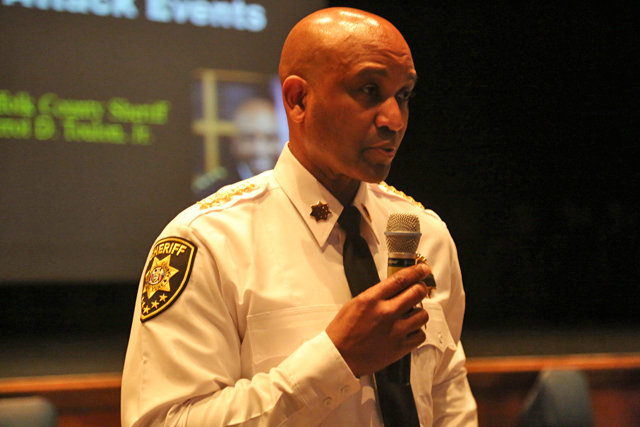Training outlines how to respond during an active shooter situation


Avoid. Deny. Defend.
Those three steps are critical for anyone who finds themselves in an active shooter situation, according to a presentation by the Suffolk County Sheriff’s Office.
Sheriff Errol Toulon Jr. spoke at Riverhead High School Monday afternoon during a Civilian Response to Active Attacks training, part of a national curriculum formed by the Department of Justice. Riverhead Central School District faculty and staff gathered in the auditorium not just to learn what to do in a school shooting, but any shooting situation.
“The importance is really a recognition of what’s going on around you,” Mr. Toulon said. “It’s an awareness so residents can understand what they should be doing if they’re faced with this type of threat.”
While school shootings continue to plague the nation, Mr. Toulon noted most attacks still occur in businesses and commercial buildings.
When Mr. Toulon took office in January, he focused an initiative on combating opioids, gangs, bullying and vaping. School safety quickly became a bigger part of the initiative as shootings continued to make headlines around the country.
“After Parkland occurred, and talking to school administrators and also students, there was definitely a concern with school safety,” Mr. Toulon said.
He held a forum with public and private school superintendents to gauge their concerns. From that, the Sheriff’s office opened a program that allows districts to have their security and threats assessed. Riverhead Superintendent Aurelia Henriquez said Riverhead schools have not yet been assessed, but will do so in the future.
“Dr. Toulon’s forum was probably the best training that I had attended and I asked him if he would provide training for the district,” Ms. Henriquez said.
All faculty and staff were required to attend one of three presentations, although Ms. Henriquez said that the presentations would have been widely attended regardless.
“Not only in the school districts, but just with our society in general,” Mr. Toulon said. “What if you’re in a movie theater, like in Aurora, Colorado? What if you’re in a mall? What if you’re in a workplace?”
“You probably know a second or third way out of the school building, but do you know a second or third way out of the restaurant that you’re eating in?” Deputy Sheriff William Weick asked. “We want you to start thinking about that.”
Mr. Weick played a 911 call during the 1999 Columbine High School shooting, where a woman called the police and was just overwhelmed and confused about the situation. She thought, “it was just a cap gun.”
“Granted, in 1999 it was a lot less likely that this was something that was transpiring as it is today,” Mr. Weick said. “If we don’t envision that it’s possible, we can’t prepare for it. We’re just going to freeze up if we have no mental preparedness.”
There are three phases that people go through in an active shooter situation: denial, deliberation and the decisive moment. The 911 caller was in the denial phase, which delayed preventative action. He urged everyone to imagine possible scenarios now in order to get past the denial phase as quickly as possible if an event were to occur.
“We want to recognize immediately that those are gunshots. We need to close the door, shut the blinds and take action,” Mr. Weick said. “If you hear something that sounds like gunfire, it probably is.”
During an active shooter, the first option is to avoid the situation if possible by exiting the area or leaving. If not, deny the shooter entry to the classroom or area and shut off the lights while keeping students out of sight. As a last resort, experts suggest defending by fighting, whether by teaming up on the shooter to grab the gun or thinking outside the box to protect students.
As heart rate increases, fine motor skills decrease. When the heart rate reaches 175 bpm, that is when the fight, flight or freeze instincts kick in, Mr. Weick said. He recommends deep breathing to calm down in order to ensure the teacher or adult in the school can carry out responsibilities, like locking the door.
Another major point was for staff to look out for troubling students who they suspect might be prone to violence. He urged teachers to notify officials if they see any troubling artwork, writings, social media posts, rumors, or personal knowledge of past violence, which is the largest indicator of a shooting.
“You’re not helpless,” Mr. Weick said. “What you do matters.”
Photo: Sheriff Errol Toulon spoke to Riverhead Central School District faculty and staff about what to do in an active shooter situation Monday afternoon.








